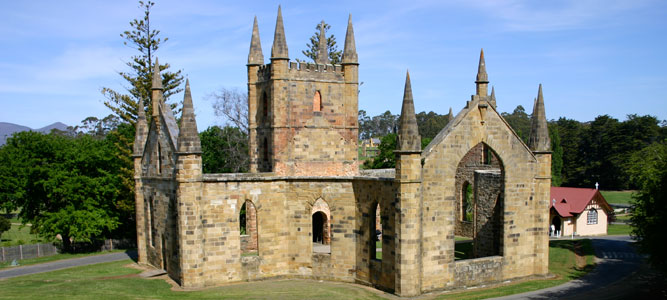Port Arthur & The Tasman Peninsula
It is for a good reason that Port Arthur is regarded throughout the world as a site of historic significance and a place of great beauty. It is easy to spend a day or two wandering this old penal station, in awe of what once was and the outstanding job of restoration and preservation that has been carried out. However, as fascinating as it may be, there is more to the region than Port Arthur. The entire Tasman Peninsula is scattered with natural and historic attractions. Even if Port Arthur did not exist, the Tasman Peninsula would still be a terrific place to visit. In this article we look at some of the region’s highlights.
Eaglehawk Neck
By road, the only way onto the Tasman Peninsula is via a narrow strip of land called Eaglehawk Neck. This strip is so narrow that you could throw a stone from one shore to the other. During convict times 18 ferocious dogs were chained in a line across the neck to stop convicts escaping the peninsula. At the narrowest point of the neck is a statue of a chained dog, showing the line’s exact position. A few escapes were made by swimming, but these were rare as the sea was reputed to be shark-infested, a belief that was encouraged by the jailers. An enterprising convict, who had been responsible for feeding the dogs, made good an escape by befriending one animal which eventually become tame enough to let him pass. The convict had become so fond of the dog that he took the friendly canine with him!
Also at Eaglehawk Neck is the historic officers quarters, believed to be the oldest wooden military structure in Australia. It has outstanding interpretation and entry is free.
After leaving Eaglehawk Neck, take the first turn left and head towards the strange little shack-village of Doo Town. Most of the shacks at Doo Town have been given names containing the letters ‘doo’. There are names like Doo-Drop-Inn, Rum Doo and Make Doo. See how many you can spot.
This part of the peninsula also has spectacular natural, sea-carved formations such as the Blowhole, Tasman Arch and the Devils Kitchen. Here, if you are brave enough, you can walk along the edge of the highest sea-cliffs in the Southern Hemisphere.
Tasmanian devils
Once back on the Arthur Highway and on your way to Port Arthur you pass through Taranna. Here you will come across the Tasmanian Devil Conservation Park, the world’s original Tasmanian devil centre. Established in 1978, it has attracted more than a million visitors. The park has recently been rebuilt to the master plan of Jon Coe, a world-leading zoo architect who has worked at 150 of the world’s great zoos.
This new concept for presenting Tasmanian devils includes an inside-out, un-zoo display where visitors are locked-up inside the old enclosure and the animals run freely on the outside. There is also a face-to-face devil dome where visitors can get nose-to-nose with devils, and a farmyard display that demonstrates that devils and human activity can happily exist side-by-side. The park has a lot more to offer than just Tasmanian devils – it is a ‘must-do’ visit.
Port Arthur
Port Arthur is not only a spot to visit for anyone coming to Tasmania, it’s also a great place for locals who haven’t been there for a few years. They’ll be surprised at how much the site has developed. Australia’s best preserved convict settlement, Port Arthur is now included on the World Heritage List. A high level of conservation and interpretation has turned the site into an outstanding heritage experience.
With more than 30 historic buildings, extensive ruins and beautifully restored gardens, Port Arthur is a widespread site, so wear good walking shoes. It offers a wide range of experiences, and they are all worth doing – so don’t rush your trip. There is a harbour cruise and numerous guided tours, not only around the actual site but also to the Isle of the Dead Cemetery and the Point Puer Boys’ Prison. Three thousand boys, some as young as nine-years-old, were sentenced to the Point Puer Boys’ Prison from 1834. It was the first reformatory built exclusively for juvenile male convicts in the British Empire. The guides explain the reformatory in the context of its time, and although conditions may seem harsh to us, every effort was made to reform the boys and supply them with a trade.
An after-dark lantern-lit ghost tour of Port Arthur is also a must-do. The guide relates strange occurrences and sightings that have been documented from the convict period until the present.
There is a wide range of accommodation and dining opportunities on the Tasman Peninsula. The Fox and Hounds restaurant is highly rated by locals as well as visitors. Eucalypt Cafe does great coffee and food and the Port Arthur Cafe at the visitor centre is very good as well.
Sea cruising
Tasman Island Cruises offers three-hour boat trips along the coastline between Eaglehawk Neck and Port Arthur. The boats are especially designed for ecotourism. You will experience the highest sea-cliffs in the Southern Hemisphere and weave in and out of deep-sea caves. Seals and birds abound, and if luck is with you, whales and dolphins. Boats leave from Port Arthur and it is important to book. Visit Tasman Island Cruises at www.tasmancruises.com.au
Coal Mines Historic Site
After leaving Port Arthur, turn onto the loop road (Nubeena Road) that takes you through Nubeena and Premaydena where can you turn off onto Saltwater River Road for another ‘must-see’, the Coal Mines Historic Site. This site was a part of the structure of prisoner discipline and punishment emanating from Port Arthur. It was regarded as a punishment station for repeat offenders, although there is some doubt as to whether it was as bad as its reputation warranted. The coal mines opened three years after Port Arthur and within a few years they were producing most of the coal used in Van Diemen’s Land.
Punishment cells survive in remarkably good condition and the surrounding bushland has well marked tracks leading to the remains of old buildings that once made up this extensive site. At its peak it was a settlement of 600 prisoners along with their jailers and families. Entry is free.
These are just some of the attractions that the Tasman Peninsula has to offer. Work is currently under way on the Three Capes Track, a bushwalking experience that is expected to be world class. The region also provides some of the state’s best fishing and what is regarded as the world’s best temperate water diving is available off the Tasman National Park.
Words and Images: Steven French


